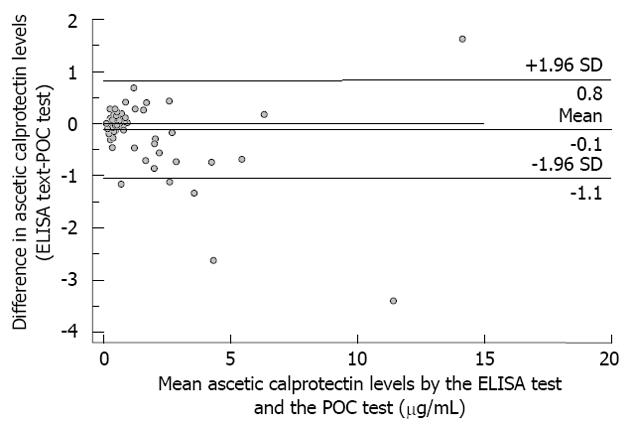Copyright
©2013 Baishideng Publishing Group Co.
World J Gastroenterol. Apr 7, 2013; 19(13): 2028-2036
Published online Apr 7, 2013. doi: 10.3748/wjg.v19.i13.2028
Published online Apr 7, 2013. doi: 10.3748/wjg.v19.i13.2028
Figure 1 Measurement of ascitic calprotectin with the enzyme-linked immunosorbent test and the point-of-care test (Bland Altman plot).
The differences between the results of the enzyme-linked immunosorbent (ELISA) and point-of-care (POC) tests in each patient are plotted against the mean of the two measurements, showing the limits of agreement, defined as the mean ± 2 SD of the difference.
Figure 2 Ascitic calprotectin values in patients with normal and elevated ascitic polymorphonuclear cell count.
Box-and-whisker plot representing the median, 25th to 75th percentiles, minimum/maximum values, and outliers outside 1.5 times (circle) and 3 times (cross) the interquartile range of ascitic calprotectin values, measured with the enzyme-linked immunosorbent (ELISA) test (A) and the point-of-care (POC) test (B). PMN: Polymorphonuclear.
Figure 3 Receiver operating characteristics analysis of the enzyme-linked immunosorbent test and the point-of-care test to identify elevated ascitic polymorphonuclear cell count.
The area under the receiver operating characteristics curve (AUC) for ascitic calprotectin for identifying a polymorphonuclear count > 250/μL. No differences between the two tests (P = 0.155) were detected. The diagonal line represents no discrimination. POC: Point-of-care; ELISA: Enzyme-linked immunosorbent.
Figure 4 Diagnostic accuracy.
For the enzyme-linked immunosorbent (ELISA) test, the overall test accuracy of ascitic calprotectin was 87% when 0.63 μg/mL was used as the best cut-off value (A) and was 84% for the point-of-care (POC) test when 0.51 μg/mL was used as best cut-off (B). PMN: Polymorphonuclear.
- Citation: Burri E, Schulte F, Muser J, Meier R, Beglinger C. Measurement of calprotectin in ascitic fluid to identify elevated polymorphonuclear cell count. World J Gastroenterol 2013; 19(13): 2028-2036
- URL: https://www.wjgnet.com/1007-9327/full/v19/i13/2028.htm
- DOI: https://dx.doi.org/10.3748/wjg.v19.i13.2028












